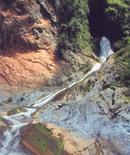A destination for Challengers
Cuba packs quite a punch for adventure travelers. Its breathtaking scenery captivates visitors and the Topes de Collantes Grand Park is a good case in point. Embracing over 130 square miles, the park is perched on the Guamuhaya mountain range of the Sierra del Escambray, on the southern side of the central province of Sancti Spiritus. This rugged and mystical region features the island nation's second-highest mountain, the 1,140-meter-high San Juan Peak (above sea level). The mountainous ecosystem provides an eye-popping view. Its wide in-between valleys, caverns, narrow rapids of crystal-clear water and the jaw-dropping waterfalls are nothing but samples of what this humongous paradise actually has to offer.
EMOTION AND RELAXATION Driving up to Topes de Collantes on the road that hooks up the cities of Cienfuegos and Trinidad, bordering the southern coastline, is a must-see. The way up is packed with emotions only comparable to La Farola road in the easternmost tip of Cuba. Reaching up a height of over 600 yards gives the possibility of unearthing the first reason anyone might have for taking on this trip: the landscape.
Right before your very eyes, spreading like a huge green and bright carpet, the Valley of the Sugar Mills –a former enclave of wealth in 19th century's Cuba- is flanked by the deep blue Caribbean Sea. To the left, belfries and kilned clay roofs of Trinidad's houses dominate all sights. The whole panorama comes on at one fell swoop, showing off a place that UNESCO declared Heritage of Mankind a few years ago.
The Grand Park's jungle sports an assortment of woods and forests. Countless fruit trees, medicinal shrubs and hardwood plants grow and bloom on the premises all year round. Tree-climbing ferns and coniferous forests are almost everywhere.
There's a variety of ecotourism programs, ranging from more conventional packages aimed at hikers to others designed for bolder trekkers. There are also horseback rides up and down the slopes, some of them stretching out for up to four days in a row, as well as great camping sites for speleologists.
The big whole is divided in eight different parks: Caburni, Vegas Grandes, Guanayara, Codina, Javira, El Cubano, Cayo Iguana and El Nicho. Caburni and Vegas Grandes harbor the biggest challenges for derring-do seekers. Their highly specialized trails take pathfinders that are in good shape and have vast mountain climbing skills (some peaks here are more than 650 yards high).
Caburni is one of the milestones of the Sierra del Escambray. The main course is a waterfall named after the place that features a 60-yard-high nonstop freefall of water. Trailblazers need to climb 45-degree slopes to reach the top of that hill. On the other hand, both your mind and body must be in great shape if you truly want to get to the waterfalls of Vegas Grandes and feast eyes on a paradise-like universe. Make light of the many natural obstacles that you might find on your way to the top. Don't give in.
Guanayara is the name of a not-so-hard-to-climb park that makes way for the Centinelas del Rio Melodioso (Caretakers of the Melodious River) trail. This spot is pocked by numerous natural pools and is home to the El Rocio (The Dew) waterfall, right in the heart of the Escambray jungle.
But rookies may cut their trailblazing teeth in the Javira Park, a forest highly coveted by birdwatchers, while the El Cubano and Codina paths are more conventional, less spectacular and designed for people with a green thumb.


































































